
Table of Contents

|
|||||||||||||||||||||||||||||||||||||||||||||
|
|||||||||||||||||||||||||||||||||||||||||||||
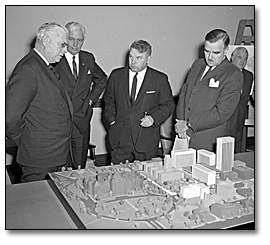
Click to see a larger image (185K) |
Plans to address this trend began during the government of Leslie Frost (1949-1961) and culminated in April 1962 when then premier John Robarts announced a project to build the largest single office building ever undertaken in Toronto. Occupying close to two city blocks, the new building would provide almost 900,000 square feet of new space. Located at the south-west corner of Bay and Wellesley streets, four towers (named after former premiers of the province: Hepburn, Ferguson, Hearst and Mowat) would be set at the corners of a two-storey central core, named to commemorate the province's first premier, John Sandfield Macdonald. |
||||||||||||||||||||||||||||||||||||||||||||
|
|
|||||||||||||||||||||||||||||||||||||||||||||
|
Responsibility for implementation of the project fell to Ontario's Department of Public Works (DPW) and on January 11, 1965, Premier Robarts and DPW Minister, Ray Connell performed the official groundbreaking ceremony. Using high quality materials and adhering to an International aesthetic in architecture, the Macdonald Block's spacious two-storey lobbies and wide, marble-lined corridors, offered excellent potential for the installation of commissioned works of art. |
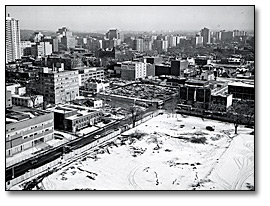
Click to see a larger image (326K) |
||||||||||||||||||||||||||||||||||||||||||||
|
|
|||||||||||||||||||||||||||||||||||||||||||||
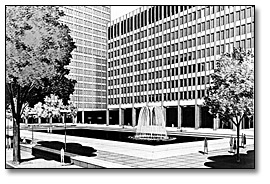
Click to see a larger image (312K) |
Recognizing that the building programme should address issues beyond the basic need for increased office space, the announcement to incorporate artworks into the complex and its proposed budget was made by the Minister early in 1963. The importance of such an undertaking was further reiterated by the Premier in the Ontario Legislature immediately following the installation of the majority of the works. |
||||||||||||||||||||||||||||||||||||||||||||
|
|
|||||||||||||||||||||||||||||||||||||||||||||
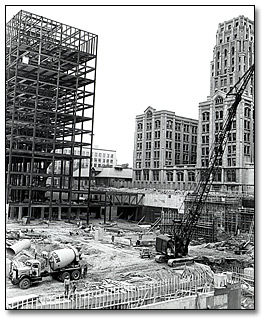
Click to see a larger image (484K) |
While the buildings of the Queen’s Park Complex, are of course, primarily utilitarian, the architects felt that decorative panels, works of art and several major pieces of sculpture would add interest to corridors, foyers and gardens, encourage recognition of the creative abilities of Canadian artists and craftsmen, and generally enhance the aesthetic aspects of these new facilities. The Royal Canadian Academy of Arts (R.C.A.) was approached for advice on the acquisition and placement in the building of suitable works. The Academy, founded in Canada in 1880 under the royal patronage of H.R.H. the Princess Louise and the Marquise of Lorne, then Governor-General of Canada, represented a solid tradition of established art making. |
||||||||||||||||||||||||||||||||||||||||||||
|
|
|||||||||||||||||||||||||||||||||||||||||||||
|
It suggested three individuals who would form an Art Consultant Committee; they were artists Cleeve Horne, R.C.A. (Chairman), Peter Haworth, R.C.A. and Clare Bice, R.C.A. Almost a year was spent in gathering information and compiling details of artists and their work until, by March 24th 1966, the committee was ready to make its recommendations. In addition to providing location plans, it suggested that five major sculptural works be acquired through a competition limited to ten of Canada’s most prominent sculptors. Also, that up to twelve minor sculptural pieces be purchased directly from younger up and coming Ontario artists. |
![Photo: Art Consultant Committee Members Cleeve Horne and Clare Bice with Sculptor, Gerald Gladstone, [ca. 1968]](pics/gr_06_gladstone_men_bw_270.jpg)
Click to see a larger image (197K) |
||||||||||||||||||||||||||||||||||||||||||||
|
|
|||||||||||||||||||||||||||||||||||||||||||||
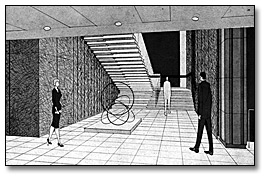
Click to see a larger image (288K) |
For the interior public spaces of the Macdonald Block’s central core, another twenty-five works, could be obtained through commission or competition from a selected group of artists. Although the majority of the artworks were to be solicited from Ontario artists, it was also recommended that artists across Canada be approached in order to acquire the best possible work. (Unfortunately, the plan to acquire twelve smaller sculptures from the younger artists was dropped in early 1967). |
||||||||||||||||||||||||||||||||||||||||||||
|
The commissions for the decorative interior panels were awarded to artists working in a wide range of styles (from Jack Bush, Harold Town and Kazuo Nakamura to A. J. Casson and Alan Collier). As well, there was an obvious attempt to present a diversity of materials including painted murals, textiles, stained glass, mosaic, ceramic, acrylic and metal. Regarded today, the total effect is one of great variety presented via a wide range of subtle and direct, representational and abstract works. |
|||||||||||||||||||||||||||||||||||||||||||||
|
Of the ten artists invited to participate in the sculpture competition, eight submissions were received. Five of these were selected by the committee: a two-piece bronze work by Quebec sculptor Louis Archambault for the Grosvenor Street entrance to the building; a smaller bronze by British Columbia resident Jack Harman for the area between the Macdonald and the older Whitney Block; Alfred Cox’s construction of metal and glass for the interior courtyard; Toronto artist Walter Yarwood’s bronze screen for the Wellesley Street entrance to the building, and Toronto sculptor Gerald Gladstone’s acrylic and steel sculpture for the main entrance to the complex off Bay Street. |
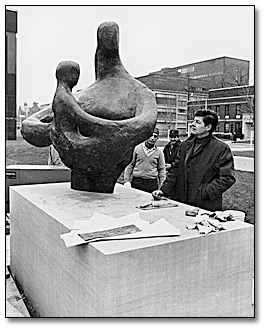
Click to see a larger image (309K) |
||||||||||||||||||||||||||||||||||||||||||||
|
|
|||||||||||||||||||||||||||||||||||||||||||||
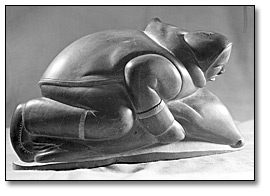
Click to see a larger image (187K) |
With the major sculptural pieces chosen, it was decided to pursue the commissioning of a sixth work, a sculpture by Inuit artist, Paulosie Kanayook. Kanayook was from Povungnituk which lay on the shores of Hudson Bay in northern Quebec. His small soapstone carving, Hunter with Seal, had been obtained by the Art Consultant Committee and it was proposed that this be used as the model for a larger work. |
||||||||||||||||||||||||||||||||||||||||||||
|
|
|||||||||||||||||||||||||||||||||||||||||||||
|
Building delays frustrated the plans for the installation of the commissioned works, originally set for September of 1967. This work was finally accomplished the weekend of November 30, 1968 when all pieces, with the exception of one, were installed. Premier Robarts rose in the House on December 5 to report on the conclusion of the project. Citing by name all of the artists, he also encouraged the members to see the works for themselves, "I hope, Mr. Speaker, that all the members will take some time to view the works. They are excellent examples of contemporary art in a variety of forms." |
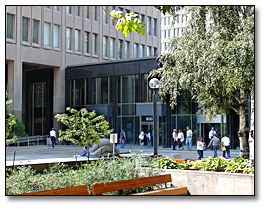
Click to see a larger image (279K) |
||||||||||||||||||||||||||||||||||||||||||||
|
|
|||||||||||||||||||||||||||||||||||||||||||||
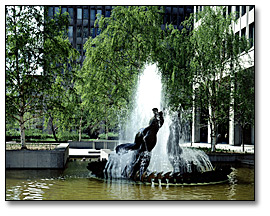
Click to see a larger image (532K) |
With the addition in 1972 of Gerald Gladstone’s sculpture fountain, The Three Graces, the final tally for the Macdonald Block project was thirty commissions made to twenty-nine artists at a cost of $382,473. For the commitment it made to Canadian art and artists, and the variety of media it represents, it remains a precedent setting initiative. Although cancelled in 1995, the Art-in-Architecture Programme saw the addition of over 600 works of contemporary art to the Government of Ontario Art Collection spread throughout government buildings across the province. |
||||||||||||||||||||||||||||||||||||||||||||
|
|||||||||||||||||||||||||||||||||||||||||||||

































